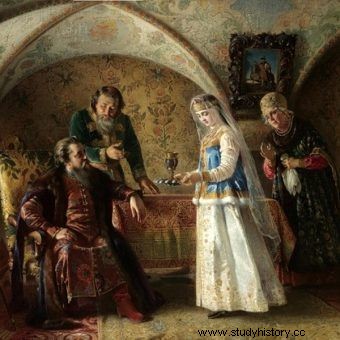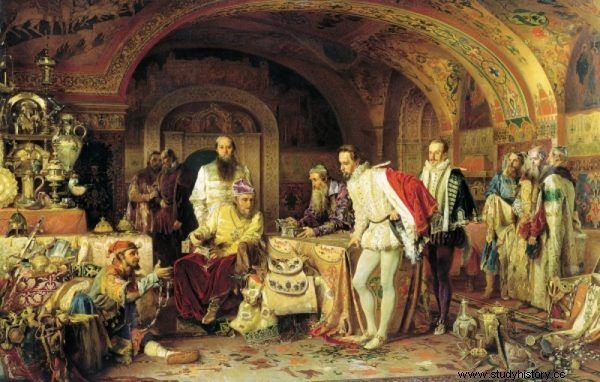The Russians were able to raise the principle "my home - my fortress" to a completely new level. Behind high fences, heavy gates and doors closed with a padlock, however, they did not keep rubies and goldheads, but ... their own wives and daughters.
Foreigners who came to the tsarist state in the 16th or 17th century were amazed at the rules that prevailed in the homes of wealthy Russians. Women from local families were guarded like an eye in the head. They were protected in a complicated way from strangers eyes and meetings with people who could jeopardize their honor.
Contacts between Russian women and strangers were kept to a minimum. As the historian Natalia Pushkarieva explains, the boyar's wife or daughter was allowed to participate only in a ritualized welcome to the guest of the house. She was supposed to give him wine and then ... she was herded back to her rooms.

A scene from the life of boyars in the 17th century (photo:public domain)
The mere possibility of looking into the hostess's eyes was a great honor. Every day, wealthy women did not leave their homes. If this happened, matrons wore veils over their faces and moved in closed sleds or carriages. Such isolation was a determinant of the status of the family. After all, those women were isolated who did not have to (and could not!) Work or even be responsible for any errands.
Violetta Wiernicka in her book "Polish Women Who Ruled the Kremlin" cites the account of a foreigner who explained how far this "closed life" was. He was especially intrigued by extending the isolation to the realm of faith as well:
Lucky ladies have received husbands who are not very jealous and allow them to visit the temple. But women enter the church through a separate door and pray in a place specially designated for this purpose, invisible to the rest of the faithful.

Wife of a Russian boyar (photo:public domain)
Moreover, the women could not walk to the place of prayer. They had to travel in a closed carriage. Not only could no one see them, but they were also not allowed to look at passers-by.
In order to hide their wives and daughters from the eyes of the public, wealthy men had bull blisters stretched in the windows of the carriages that let the light pass through, but didn't let you see anything that was going on inside or outside.
Russian women complied with these requirements not only out of concern for their own virtue, but also out of pure necessity. It was clear to no one that husbands' power over wives was absolute. This is explained in detail on the "Household" cards.
The Patriarchy Handbook
This monument of Old Russian literature, dating from the 15th century, regulated the principles of the most important branches of human existence, from obligations towards God and the Tsar, through family life, to running a house. At the behest of Ivan IV the Terrible, his pop confessor Sylvester re-edited it in 1560.
As the work taught, it was the woman's responsibility to control the chaos at home, but the husband and father were the undivided rulers. Violetta Wiernicka, author of the book "Polish Women Who Ruled the Kremlin" explains:
The family was to "function like an order whose prior was a man." It was the duty of the wife to acknowledge her husband's headship and to consult him in all matters; the influence of women was limited to the kitchen and pantry. The children were also to recognize their father as an oracle. The ideal relationship between the household members was "almost slave fear" of husband and father who had the unfettered right to raise and punish his children and wife.
This thoroughly patriarchal society did not even allow a woman to decide her own fate after the death of her husband. She had to remain completely dependent on the male guardian, so her son or other relative began to rule her life.
Women were also not allowed to correspond or read. Their literacy was considered indecent.

Tsar Ivan the Terrible, who has applied for a new editorial office of Domostroj, boasts of his treasures (photo:public domain)
You must know everything
Before outsiders, it was as if the boyars' wives lived idly and passively. However, it was a completely false picture.
The housewife had to work hard and be able to perform all the tasks related to running the farm, from weaving and sewing, through cooking, to animal husbandry. As advised by "Domostroj", her task was to educate younger women, and the knowledge of all the activities made it possible to effectively supervise their performance by other people.
Additionally, the wife of a boyar or a wealthy merchant should stand up in front of the servants to set a good example and at the same time look at their hands so that her farm is not robbed by accident.
It would be best if all the remnants of the fabric left after the knitting need to be carefully counted and kept under lock and key. Speaking of fabrics, it is impossible not to mention that sewing was to be the main and most appropriate activity for the ladies of the house. As described by Pushkaraeva, the surprised German diplomat Adam Olearius describes it:
Their main activity is sewing or embroidering white taffeta or cloth handkerchiefs, or making small bags and the same toys.

Interior of a boyar residence (photo:public domain)
The foreign visitor undoubtedly assumed that this is how every day of Russian women looks like. It is not surprising, since the hostess, if she has already had contact with strangers visiting the house, should, according to "Domostrój", talk to them ... about her needlework and embroidery.
The author of the work also instructed that fencing with a needle and thread is the best occupation for a woman, which allows her to shine with feminine virtues. As Pushkariewa emphasizes, only at the bottom of the list of tasks listed in "Domostrój" were issues related to motherhood. It was more important to keep a well-oiled household machine running.
A Polish woman changes everything?
As Violetta Wiernicka explains in "The Polish Women Who Ruled the Kremlin", this organized world was shocked only when a lady from the Vistula appeared at the top of the Russian government. Agafia Gruszecka was a seventeen-year-old noblewoman using the Polish coat of arms of Lubicz. Nineteen-year-old Tsar Fedor III fell in love with her at first sight, when he saw her in the church and decided to marry her.
The girl shocked not only with her clothes (she did not cover herself tightly like Russian women and showed a fragment of her hair), but also with manners (when the tsar came to her house, she courageously went out to him and talked with him about her own affairs) and education (she played the harpsichord, knew Latin and understood French).

Agafia and Fyodor on the Orthodox icon (photo:Shakko, license CC BY-SA 3.0)
When the couple got married in 1680, Agafia began to influence her husband to adopt somewhat looser customs, more similar to the Polish ones. First, she gave her sister-in-law more freedom (earlier they could not even decide what they would eat for dinner or what to wear). She later persuaded Fyodor to order court officials to abandon their long boyar robes and eventually cut their beards and hair.
Moreover, instead of letting herself be locked in secluded chambers, the tsarina began to participate in public life with her husband and, as Violetta Wiernicka writes, she organized the first name-day party in history and invited all the boyars to it. Although Agafia died in childbirth at the age of eighteen, the changes initiated by her could not be undone.
Twenty years later, Tsar Peter I, Fyodor's brother, went even further. He started organizing so-called assambleje , which boyars were obligated to come with their wives and daughters, who, in addition, were supposed to wear a European one. As Wiernicka says in the book Polish Women Who Ruled the Kremlin , The tsar fell into a rage when his subjects tried, under various pretenses, to prevent their wives and daughters from attending these parties. Meanwhile, the ladies very quickly developed a taste for their newly gained freedom and did not intend to give up this progressive emancipation.
Information sources:
- Evans-Clements B., A History of Women in Russia. From Earliest Times to the Present , Indiana University Press 2012.
- Pushkareva N.L., Women in Russian History:From the Tenth to the Twentieth Century , ME Sharpe Inc 1997.
- Wiernicka V., Polish women who ruled the Kremlin , Bellona 2018.
